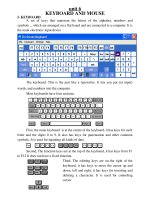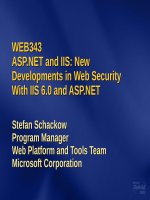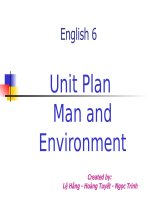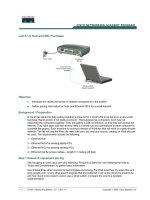6 wind and solar grid codes
Bạn đang xem bản rút gọn của tài liệu. Xem và tải ngay bản đầy đủ của tài liệu tại đây (1.19 MB, 56 trang )
Power Systems & Energy Course:
Wind and Solar
Grid Codes
Jason MacDowell
Wind Grid Codes
- North American Experience
© 2016 General Electric International, Inc. All rights reserved. Not for distribution without permission.
2/
US Grid Code Development
In the US, relationships between transmission system
operators (TSO), generators and users of energy are governed
by multiple entities:
•
•
•
•
•
•
•
FERC (Federal Energy Regulatory Commission)
NERC (North American Reliability Council)
Regional Reliability Councils (e.g.:)
- WECC (Western Energy Coordinating Council)
- ERCOT (Electric Reliability Council of Texas)
State Reliability Councils
State Regulators
Standards Organizations (ANSI/IEEE/NESC/NEC)
A similar Federal/Provincial structure applies in Canada
© 2016 General Electric International, Inc. All rights reserved. Not for distribution without permission.
3/
North American Grid Code Development
In NA, rules are generally identified in terms of:
•
Reliability Standards
•
Interconnection Requirements
• These interconnection requirements correspond
approximately to European Grid Codes
The objectives are:
• To make sure generation and transmission is efficient and
reliable, and
• To regulate rights and responsibilities of generators, TSO’s and
energy users.
Note: Interconnection Requirements for Wind Energy in the US are
continuing to develop. Regulating groups (FERC) and Reliability
groups (NERC) are debating terms of current grid codes.
© 2016 General Electric International, Inc. All rights reserved. Not for distribution without permission.
4/
Grid Code Development
Debate…
•
Should wind generation be treated differently?
•
What is the obligation of generation to provide
voltage control?
•
How should generation respond to system
disturbances?
•
How should generation prove it meets performance
requirements?
These questions are still being debated in the US
today.
© 2016 General Electric International, Inc. All rights reserved. Not for distribution without permission.
5/
What consensus is emerging NA Grid Codes?
•
Reactive Power: +/- 0.95 pf @ POI
•
Voltage Control: required, with ISO voltage setpoints
•
Frequency Tolerance: +/- 3 hz continuous
•
Voltage Tolerance (Low Voltage Ride-Through): ZVRT (FERC
661a), NERC PRC-024
•
Models and Data: required cooperation
•
Telemetry and Metering: specific minima
•
Power Quality: IEEE 519 for Harmonics and Flicker
•
Frequency Control: debate just starting
•
Validation requirements: NERC MOD Standards
•
Plant Protection Coordination: NERC PRC-019
© 2016 General Electric International, Inc. All rights reserved. Not for distribution without permission.
6/
Wind Grid Codes
- Development and Harmonization
Discussion
© 2016 General Electric International, Inc. All rights reserved. Not for distribution without permission.
7/
Grid Code Development –
Utility and Operator Perspectives
• Codes have significant impact on power system
reliability, operations and control
• Codes affect the level of wind power penetration in
the power system
• Codes affect the cost of operation and the final
cost of energy (COE) to consumers
• Individual Systems have particular requirements
© 2016 General Electric International, Inc. All rights reserved. Not for distribution without permission.
8/
Grid Code Development –
Manufacturer and Developer Perspectives
• Codes affect the level of wind power penetration in
the power system
• Codes affect the cost of wind power equipment
• Transmission operators need feedback to develop
realistic codes based on current and physically
realizable technology
• Perceived system specific requirements may, in
some circumstances, be primarily a function of
past practice rather than true system needs
© 2016 General Electric International, Inc. All rights reserved. Not for distribution without permission.
9/
Grid Code Development
Tight
More Expensive Equipment
Reduced Efficiency
Loose
Compromised System
Reliability
Grid Code Functional Specifications
Grid Codes should be no more specific than they need to be to avoid overdesigned equipment and reduced efficiency of wind generation, but should
be specific enough for adequate system reliability.
© 2016 General Electric International, Inc. All rights reserved. Not for distribution without permission.
10 /
Global Renewable Codes & Standards Development
North America
California ISO Interconnection Requirements for Variable Energy Resources
ISO-NE Technical Requirements for Wind Interconnection & Integration
NERC Standards Drafting and Task Forces
—
Integration of Variable Generation Task Force (IVGTF)
—
Essential Reliability Services Task Force (ERSTF)
—
Generator Verification Standards Drafting Team (GVSDT)
FERC now mandates that all new reliability standards address VER
International
—
IEC TC88/WG27 on Wind Models
—
IEC TC8/SC8A on Wind performance, interconnection, design and forecasting
—
Ontario IESO Amended Market Rules for Generation Facilities
—
Alberta Interconnection Requirements for Wind Generation
—
Chinese State Power Grid Technical Code for Wind Interconnection
—
Vietnamese Interconnection Requirements for Wind Generation
—
Indian CERC Electricity Grid Code for Wind
—
German FGW Technical Guidelines for Wind Energy
—
Australian Energy Market Operator (AEMO) Guidelines for Wind Energy
© 2016 General Electric International, Inc. All rights reserved. Not for distribution without permission.
11 /
NERC GVSDT* standards currently in draft
MOD (Model Validation):
MOD-025: Verification of Generator/Plant Real & Reactive capability
MOD-026: Verification of Dynamic Models and Data for Generator Excitation
Control and Plant Volt-Var Control Functions
MOD-027: Verification of Dynamic Models and Data for Turbine/Governor and
Load Control or Active Power/Frequency Control Functions
PRC (Protection & Control):
PRC-019: Coordination of Generating Unit/Plant Voltage Regulating Controls with
Unit/Plant Capabilities and Protection
PRC-024: Generator Frequency and Voltage Protective Relay Settings
Applicability has been modified to include wind & large solar.
These standards have been adopted in early 2014.
* Generator Verification Standards Drafting Team
© 2016 General Electric International, Inc. All rights reserved. Not for distribution without permission.
12 /
FAULT RIDE-THROUGH
NERC PRC-024: Generator Frequency and Voltage Protective Relay Settings
Requirement 1: Frequency Ride-Through
• Each Generator Owner (GO) shall:
– Set in service frequency protective relaying so that it does not operate to
trip the generating unit during frequency excursions within the band
described in Attachment 1
– Conditions and exceptions:
– Must operate between 59.5 and 60.5 Hz continuous
– May trip if rate of change >2.5 Hz/sec (Aurora exclusion)
Requirement 2: Voltage Ride-Through
• Each Generator Owner (GO) shall:
– Set in service voltage protective relaying so that it does not operate to trip
the generating unit during voltage excursions within the specified band
– Conditions and Exceptions:
– Consider 3-phase Zone 1 faults with normal clearing
– Site-specific clearing time may be used
– Generator tripping for SPS, RAS or to clear the fault allowed
© 2016 General Electric International, Inc. All rights reserved. Not for distribution without permission.
13 /
NERC PRC-024: Voltage Ride-Through
HVRT DURATION
LVRT DURATION
Time (Sec)
Voltage
(p.u.)
Time (Sec)
Voltage
(p.u.)
Instantaneous
1.20
Instantaneous
0.00
0.20
1.175
0.15
0.45
0.5
1.15
0.30
0.65
1.0
1.10
2.0
0.75
3.0
0.9
Generators / Plant must not
trip for credible faults inside
the zone unless:
•SPS / RAS requires it
•Generator critical clearing
time requires it
(synchronous generators)
© 2016 General Electric International, Inc. All rights reserved. Not for distribution without permission.
14 /
NERC PRC-024: Frequency Ride-Through
QUEBEC
High Frequency
Time (Sec)
Frequency (Hz)
0-5
66
5 -90
63
90 - 660
61.5
> 660
60.6
Low Frequency
Time (Sec)
Frequency (Hz)
0 – 0.35
55.5
0.35 - 2
56.5
2 - 10
57
10 - 90
57.5
90 - 660
58.5
> 660
59.4
WECC
High Frequency
Low Frequency
Time (Sec)
Frequency (Hz)
Time (Sec)
Frequency (Hz)
0 – 30
61.7
0 – 0.75
57
30 – 180
61.6
7.5 - 30
57.3
>180
60.6
7.5 - 30
57.8
30 - 180
58.4
>180
59.4
ERCOT
High Frequency
Time (Sec)
Frequency (Hz)
0 - 30
61.8
30 - 540
61.6
>540
60.6
Low Frequency
Time (Sec)
Frequency (Hz)
0–2
57.5
2 - 30
58
30-540
58.4
>540
59.4
EASTERN INTERCONNECTION
High Frequency
Low Frequency
Freq.
Freq.
Time (Sec)
Time (Sec)
(Hz)
(Hz)
0 – 10(90.935-1.45713*f)
61.8
0 – 10(1.7373*f-100.116)
57.8
10(90.935-1.45713*f)
10(1.7373*f-100.116) 60.5
59.5
Continuous
- Continuous
© 2016 General
Electric International, Inc. All rights reserved. Not for distribution without permission.
Continuous
60.5
Continuous
59.5
15 /
PROTECTION COORDINATION
NERC PRC-019: Coordination of Generating Unit/Plant Voltage Regulating
Controls with Unit/Plant Capabilities and Protection
Coordination
• Verify limiters are set to operate before protection
• Verify protection is set to operate before conditions exceed equipment
capabilities
Elements may include (but are not limited to):
•
•
•
•
•
•
•
Field over-excitation limiter and associated protective functions
Inverter over current limit and associated protective functions
Volts per Hertz limiter and associated protective functions
Stator over-voltage protection system settings
Generator and transformer volts per Hertz capability
Time versus field current or time versus stator current capability
Converter over temperature limiter and associated protective functions
© 2016 General Electric International, Inc. All rights reserved. Not for distribution without permission.
16 /
PROTECTION COORDINATION
NERC PRC-019: Coordination of Generating Unit/Plant Voltage Regulating
Controls with Unit/Plant Capabilities and Protection
Key Points
• It is intended that the coordination verification be performed prior
to performing a reactive capability test (MOD-025-2).
• This standard does not require any field testing or other
operational verification of limiters or protection. It is an
engineering study.
• Five year periodicity requirement.
• Normal five-year re-verification only requires confirmation that
the settings and equipment used in the previous study have not
changed.
© 2016 General Electric International, Inc. All rights reserved. Not for distribution without permission.
17 /
MODEL VALIDATION
NERC MOD-026: Plant Volt / Var Control
NERC MOD-027: Plant Active Power / Frequency Control
Main Requirements
• Each Transmission Planner shall provide existing model and data to the
Generator Owner within 30 days of receiving an information request
• Each Generator Owner shall provide to the Transmission Planner a verified and
accurate model in accordance with the standard’s periodicity table
• Other requirements that cover special circumstances
Staged test or ambient monitoring is allowed
The GO “owns” the model and is responsible for its validity
• Responsible for selecting proper structure and determining parameters
• Responsible for determining if match is “good enough”
• Peer Review process is included to facilitate technical discussions between the
Generator Owner (GO) and the Transmission Planner (TP)
© 2016 General Electric International, Inc. All rights reserved. Not for distribution without permission.
18 /
MODEL VALIDATION
NERC MOD-026: Plant Volt / Var Control
NERC MOD-027: Plant Active Power / Frequency Control
To mitigate the reliability gap associated with Variable
Energy Resource (wind/solar) modeling:
• Applicability section expanded
– Based on review of in-service renewable plant plant data that includes
approximately 80% of the plant MVA capacity in each Interconnection
– The MVA threshold for plants was decreased from
– 200 MVA to 100 MVA for the Eastern and Quebec Interconnections
– 150 to 75 MVA for the WECC Interconnection
– 100 to 75 MVA for the ERCOT Interconnection
– Note: reducing the MVA threshold for plants in ERCOT any further
would have exceeded the NERC Compliance Registry criteria.
– The language makes clear that units less than 20 MVA should be verified in
aggregate when possible
• Targeted 2 to 11 year phase-in period and 10 year periodicity
© 2016 General Electric International, Inc. All rights reserved. Not for distribution without permission.
19 /
Existing NERC Standards
Relevant for Renewables
© 2016 General Electric International, Inc. All rights reserved. Not for distribution without permission.
20 /
VOLTAGE REGULATION
NERC VAR-001: Voltage and Reactive Control
NERC VAR-002 : Generator Operation for Maintaining Network Voltage Schedules
Main Requirements
• Each Transmission Operator shall acquire sufficient reactive
resources and specify a voltage or reactive power schedule at the
POI
• Each Generation Operator shall operate each generator in
automatic regulation mode and follow the voltage or reactive
power schedule provided by the Transmission Operator or as
otherwise directed by the Transmission Operator
© 2016 General Electric International, Inc. All rights reserved. Not for distribution without permission.
21 /
DISTURBANCE CONTROL / FREQUENCY REGULATION
NERC BAL-002: Disturbance Control Performance
NERC BAL-003: Frequency Response and Bias
Main Requirements
• Each Balancing Authority shall have access to and/or operate Contingency
Reserve to respond to Disturbances. Contingency Reserve may be supplied
from generation, controllable load resources, or coordinated adjustments to
Interchange Schedules.
•
Frequency Response Obligation (FRO): The Balancing Authority’s share of the
Frequency Response required for reliable operation across the entire
interconnected system. This will be calculated as MW/0.1Hz. [Included in BAL003.1x draft, now in balloting process]
© 2016 General Electric International, Inc. All rights reserved. Not for distribution without permission.
22 /
DISTURBANCE CONTROL / FREQUENCY REGULATION
NERC BAL-002: Disturbance Control Performance
NERC BAL-003: Frequency Response and Bias
Frequency Response Measurement and Calculation
Primary Response
Reliability Risk
© 2016 General Electric International, Inc. All rights reserved. Not for distribution without permission.
23 /
Facility Connection and Modeling
NERC FAC-001: Facility Connection Requirements
NERC FAC-002 : Coordination of Plans for New Generation/Transmission/End User
NERC MOD-010: Steady-State Data for System Models & Simulation
NERC MOD-012: Dynamics Data for System Models & Simulation
Main Requirements
• Transmission Owners shall document, maintain and publish facility connection
requirements that address generation, transmission and end-users.
• Generator Owners, Transmission Owners, Distribution & Load-Serving entities
must coordinate and cooperate in system assessment that:
•
Evaluates reliability impact of new facilities/connections and ensures compliance with
NERC Reliability Standards
•
Evidence and documentation of steady-state, short circuit and dynamics analysis was
performed per TPL-001, and that study assumptions and system performance
alternatives are stated in the report.
• Transmission Owners/Planners, Generator Owners, and Resource Planners shall
provide steady-state and dynamic model data and structures that reflects the
plant design.
© 2016 General Electric International, Inc. All rights reserved. Not for distribution without permission.
24 /
Solar Codes and Standards
© 2016 General Electric International, Inc. All rights reserved. Not for distribution without permission.
25 /









